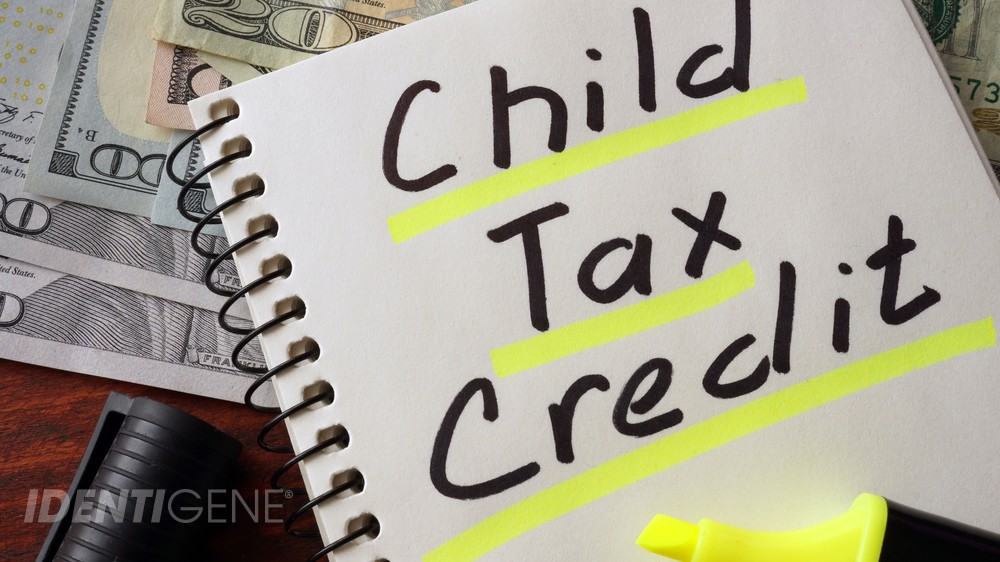If you may have fathered a child and are considering a paternity test, there are many pluses to doing so, both for the child and you. The most important benefit, of course, is that you can look forward to developing a positive relationship with your child, if circumstances allow. Besides the emotional benefits of positive paternity testing results, there may be some financial ones as well: namely, you may be able to claim the child on your taxes. Here is a quick overview of three possibilities.
This article is for informational purposes only and should not be considered tax advice. Please consult taxes professionals or the IRS website for details and direction.
 1. Tax Tip & Benefit: Claim a Child as a Dependent
1. Tax Tip & Benefit: Claim a Child as a Dependent
According to the Internal Revenue Service (IRS), a dependent is a child or other relative for whom you can claim a tax exemption.
What is a tax exemption?
An exemption is similar to a taxable-income deduction, but in this case the amount is subtracted from your adjusted gross income before the taxable income calculation.
SO WHAT’S THE BENEFIT? In a ‘real life’ scenario, when you have a dependent, it decreases the amount of federal taxes withheld in your paycheck by your employer.
There are six (6) specific qualifications that must be met in order for a child to be claimed as a dependent. The IRS term for the dependent is a Qualifying Child.
- Relationship: The child must be your daughter, son, or other qualifying relative. If you are not on the child’s birth certificate, the IRS may require that you provide proof of paternity. This proof can be provided by taking a legal (chain-of-custody) paternity test.
- Age requirements: The child must have been under the age of 19 on the last day of the year as well as younger than you. They can also be a full-time student under the age of 24 who is younger than you or a qualifying relative of any age who is permanently disabled.
- You provide more than half of the child’s support: This includes housing, transportation, medical costs, clothing, recreation, and food.
- Where the child lives: If the child has lived with you for more than half of the year, this fulfills the residency requirement.
- Join return: If the child is married and is filing a joint tax return with their spouse, this disqualifies them from exemption qualification.
- Can be claimed as a Qualifying Child by more than one person: If they can be claimed by someone else (for example, the mother’s child to whom you are not married), then you must be the person entitled to claim the child. If the parents are not married, a child cannot be claimed by both parents.
 2. Tax Tip & Benefit: Child Tax Credit
2. Tax Tip & Benefit: Child Tax Credit
Quite simply, you can get a credit worth up to $1,000 per dependent child! This credit is meant to help offset the cost of raising the child.
The requirements to qualify for the Child Tax Credit are as follows:
- The child must qualify as your dependent (see qualifications listed above).
- You must be the parent claiming the child as a dependent (if not filing jointly with the child’s mother).
- The child must have been 16 or younger as of December 31.
- The child must be a citizen of the United States, a national, or resident alien.
3. Tax Tip & Benefit: Child and Dependent Care Tax Credit
If you pay a provider to care for one or more children under the age of 13, you may be eligible for the Child and Dependent Care Tax Credit. For taxes, you can get credit for up to 35% of the costs of paying for a provider. The exact number is based on your income and the number of qualifying children.
SO WHAT’S THE BENEFIT? You could get a credit for up to the maximum of $3,000!
Taxes: How a Paternity Test Can Help
If you’re considering doing a paternity test, it’s important to understand that results for an at-home test cannot be used for any legal purpose, including establishing yourself as a legal parent. The reason is because the identities of test participants cannot be verified with an at-home test. The only paternity report accepted by the court is a legal paternity test from an accredited laboratory. So establishing legal paternity of your child is the first step to claiming any tax benefits you may qualify for as the biological father. As you can see from this article, most benefits are for fathers who take an active part in their child’s care. If a paternity test comes back positive, there are many ways to establish a fatherhood relationship-and that emotional connection far outweighs any financial benefit.Follow us on Facebook and Twitter! If you have questions about paternity tests or other DNA testing services, please contact our Client Support Center at 888-404-4363, Mon-Fri from 9 AM to 6 PM Eastern Time. Our friendly, expert representatives are ready and happy to help. Get answers anytime by visiting our Help Center.
Resources
“EITC Help.” Qualifying Child Rules. IRS, 3 Nov. 2015. Web. 04 Feb. 2016. <http://www.irs.gov/Credits-&-Deductions/Individuals/Earned-Income-Tax-Credit/Qualifying-Child-Rules>.
“Tax Credits & Tax Deductions for Parents with Children or Dependents.” List of Tax Deductions for Parents with Children, Dependents. Efile.com, n.d. Web. 04 Feb. 2016. <http://www.efile.com/tax-deductions-credits-for-parents-with-children-dependents/>.
Taxpayer, Joe. “How to Change Your W-4 Withholding to Maximize Your Tax Refund – HRBlock Talk.” HRBlock Talk. HRB Digital, LLC, 14 Jan. 2013. Web. 04 Feb. 2016. <http://blogs.hrblock.com/2013/01/14/how-to-change-your-w-4-withholding-to-maximize-your-tax-refund/>.






 How Genetic Traits are Passed On in Families:
Where our Looks Come From
How Genetic Traits are Passed On in Families:
Where our Looks Come From




